Jean Beis is pictured above in the Sandusky High
School Library, on page 20 of the 1952 Fram.
Miss Beis was born Jeanette Beis, in 1894, to local attorney George C. Beis and
his wife, the former Lucinda Zerbe. Jean graduated from Sandusky High School in
1912, and attended the University of Michigan, graduating in 1917 with a
degree in language. In 1941 she earned her bachelor degree in Library Science
from the Western Reserve University in Cleveland.
Miss Beis began teaching at
Sandusky High School in 1920, where she taught Latin for several years.
Eventually Miss Beis became the High School Librarian at Sandusky High School.
In May of 1954, a slightly overdue book was returned to the High School library
from the son of a former Sandusky resident. Though it was not collected, Miss
Beis calculated the fine for the overdue book to be $539.70.
Miss Jean Beis is
the second to the last person on the right, in the bottom row in the picture of
the Sandusky High School faculty below.
In 1951 Miss Beis attended a class
reunion. She is the person on the right in the picture below, beside Letitia Adams and an unidentified male.

 this blog
this blog




































